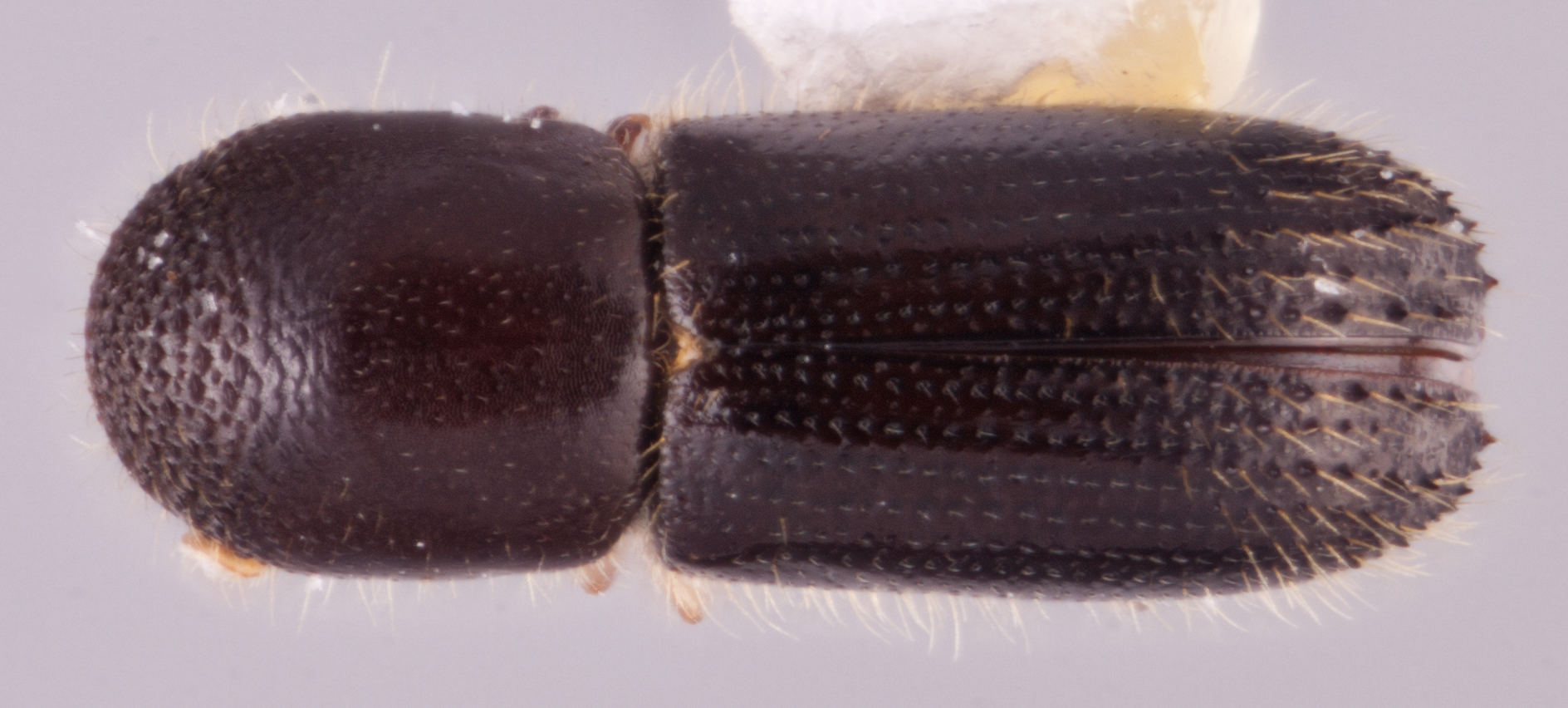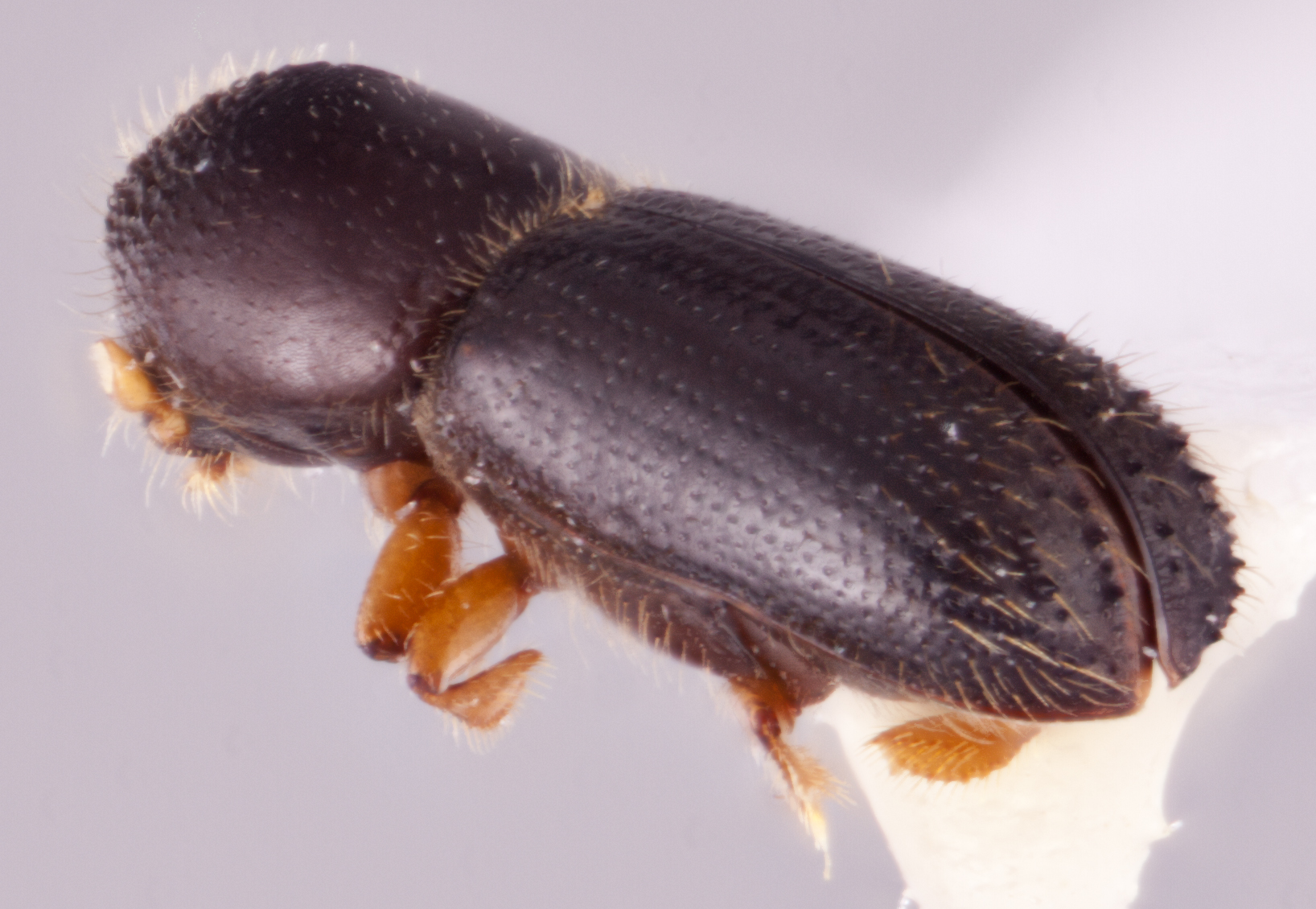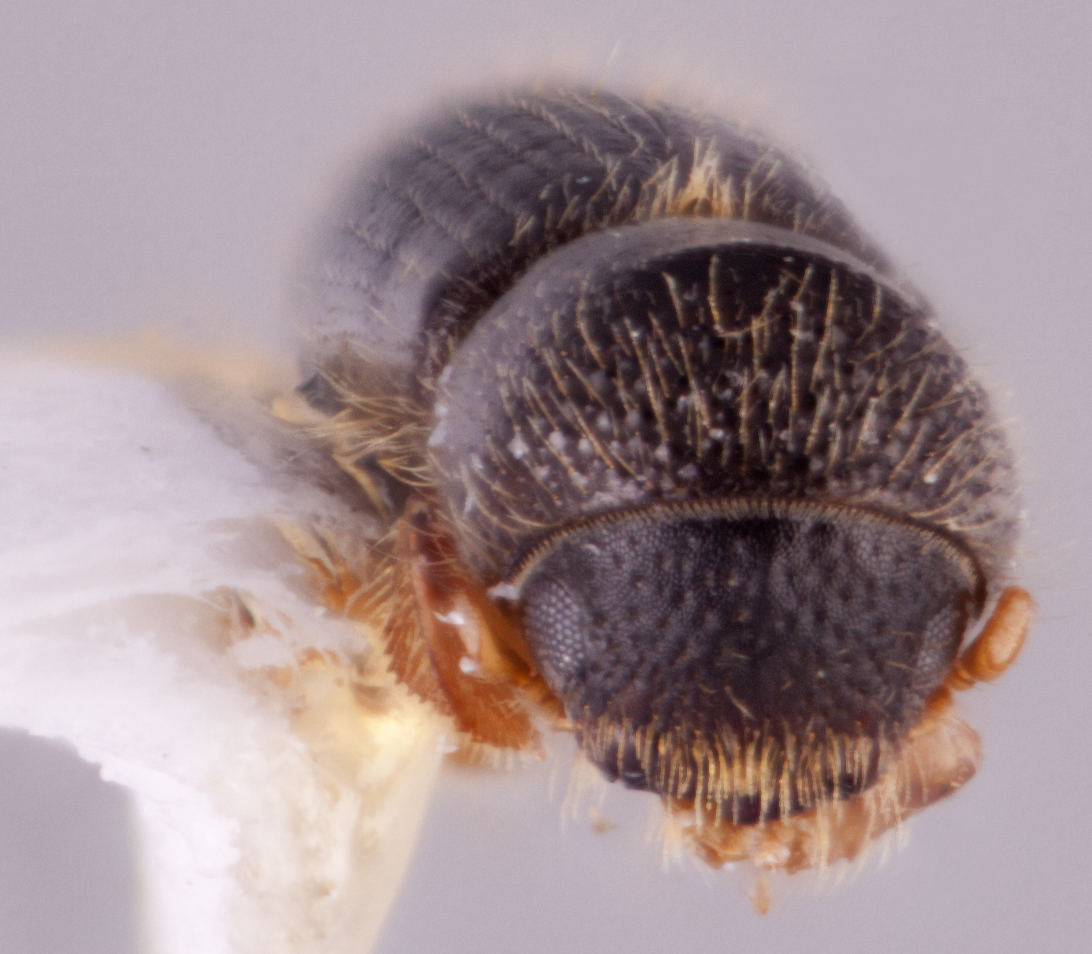Xyleborinus saxesenii
|
Xyleborinus saxesenii lateral; R.K. Osborn |
|
Xyleborinus saxesenii dorsal; R.K. Osborn |
|
Xyleborinus saxesenii declivity; R.K. Osborn |
|
Xyleborinus saxesenii frontal; R.K. Osborn |
Taxonomic history
Bostrichus saxesenii Ratzeburg, 1837: 167.
Xyleborinus saxesenii (Ratzeburg): Reitter, 1913: 79.
Synonyms
Xyleborus dohrni Wollaston, 1854: 290. Eichhoff 1878b: 362.
Xyleborus decolor Boieldieu, 1859: 473. Synonymy: Ferrari 1867: 22.
Xyleborus aesculi Ferrari, 1867: 22. Synonymy: Eichhoff 1878b: 362.
Xyleborus sobrinus Eichhoff, 1876a: 202. Synonymy: Schedl 1964d: 313.
Xyleborus subdepressus Rey, 1883: 142. Synonymy: Bedel 1888: 419.
Xyleborus frigidus Blackburn, 1885: 193. Samuelson 1981: 59.
Xyleborus floridensis Hopkins, 1915a: 60, 63. Wood 1962: 79.
Xyleborus pecanis Hopkins, 1915a: 60, 63. Wood 1962: 79.
Xyleborus quercus Hopkins, 1915a: 60, 63. Wood 1962: 79.
Xyleborus arbuti Hopkins, 1915a: 61, 64. Wood 1957: 403.
Xyleborinus tsugae Swaine, 1934: 204. Wood 1957: 403.
Xyleborinus librocedri Swaine, 1934: 205. Wood 1957: 403.
Xyleborus pseudogracilis Schedl, 1937c: 169. Wood 1989: 176.
Xyleborus retrusus Schedl 1940b, 208. Wood 1989: 176.
Xyleborus peregrinus Eggers, 1944: 142. Schedl 1980: 122.
Xyleborus pseudoangustatus Schedl, 1948: 28. Schedl 1964d: 313.
Xyleborus paraguayensis Schedl, 1949: 276. Wood 1989: 176.
Xyleborus opimulus Schedl, 1976: 77. Wood 2007: 473.
Diagnosis
2.3−2.5 mm long (mean = 2.34 mm; n = 5); 3.13−3.29 times as long as wide. This species is distinguished by the declivitaldeclivital:
pertaining to the elytral declivity
face with interstriaeinterstria:
longitudinal spaces along the elytra between the striae, which is not as<br />
impressed and bear smaller punctures.
 2 armed by granules at declivitaldeclivital:
2 armed by granules at declivitaldeclivital:
pertaining to the elytral declivity
summit, unarmed on declivitaldeclivital:
pertaining to the elytral declivity
face; declivitaldeclivital:
pertaining to the elytral declivity
interstriae 1, 3 denticlesdenticle:
a small tooth, the sides of which are equal and the tip is above the middle of the base subacutely pointed; denticlesdenticle:
subacutely pointed; denticlesdenticle:
a small tooth, the sides of which are equal and the tip is above the middle of the base on ventrolateral areas of the elytraelytron:
on ventrolateral areas of the elytraelytron:
the two sclerotized forewings of beetles that protect and cover the flight wings
small, less acute; declivitaldeclivital:
pertaining to the elytral declivity
interstriae 2 slightly impressedimpressed:
a depression in a surface
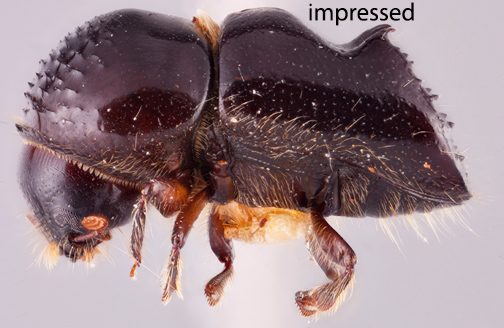 ; discaldiscal:
; discaldiscal:
pertaining to the disc of either the pronotum or elytra
interstriae 1, 2 unarmed; declivitaldeclivital:
pertaining to the elytral declivity
interstriae 2 flattened; and moderate size.
May be confused with
Xyleborinus attenuatus, X. subgranulatus, X. subspinosus, and X. thaiphami
Distribution
Occurs throughout the Palaearctic region. Recorded in the study region from China (Anhui, Chongqing, Fujian, Guangxi, Guizhou, Hebei, Heilongjiang, Hong Kong, Hunan, Jiangsu, Jiangxi, Jilin, Ningxia, Shaanxi, Shanghai, Shanxi, Sichuan, Xizang, Yunnan, Zhejiang), India (Assam, Kashmir, Uttarakhand, West Bengal), Japan, South Korea, Taiwan, Vietnam. Outside the Palaearctic, introduced and established in Australia, Hawai’i, New Zealand, South Africa, and several countries in South America (Wood and Bright 1992Wood and Bright 1992:
Wood SL, Bright DE. 1992. A catalog of Scolytidae and Platypodidae (Coleoptera), Part 2: Taxonomic index. The Great Basin Naturalist Memoirs 13: 1-1533., Kirkendall 2018Kirkendall 2018:
Kirkendall LR. 2018. Invasive bark beetles (Coleoptera, Curculionidae, Scolytinae) in Chile and Argentina, including two species new for South America, and the correct identity of the Orthotomicus species in Chile and Argentina. Diversity 10: 40. https://doi:10.3390/d10020040).
Host plants
strongly polyphagous, attacking both gymnosperms and angiosperms (Wood and Bright 1992Wood and Bright 1992:
Wood SL, Bright DE. 1992. A catalog of Scolytidae and Platypodidae (Coleoptera), Part 2: Taxonomic index. The Great Basin Naturalist Memoirs 13: 1-1533.)
Remarks
The biology of the species has been studied by Fischer (1954), Egger (1973), Hosking (1973), Peer and Taborsky (2007), Biedermann (2010), Biedermann and Taborsky (2011), and others. The larvae enlarge the gallery system as they develop, and frequently feed on fungus-infested wood rather than the ambrosia fungus alone (Wood 1982Wood 1982:
Wood SL. 1982. The bark and ambrosia beetles of North and Central America (Coleoptera: Scolytidae), a taxonomic monograph. Great Basin Naturalist Memoirs 8: 1-1359., Biedermann et al. 2009Biedermann et al. 2009:
Biedermann PHW, Klepzig KR, Taborsky M. 2009. Fungus cultivation by ambrosia beetles: behavior and laboratory breeding success in three Xyleborine species. Environmental Entomology 38: 1096-1105. https://doi.org/10.1603/022.038.0417). Peer and Taborsky (2007) show that cooperative brood care occurs within the gallery system as a result of delayed dispersal by the new generation of females, and that this can raise the number of offspring producedproduced:
referring to a part of the exoskeleton that is extended, lengthened or elevated
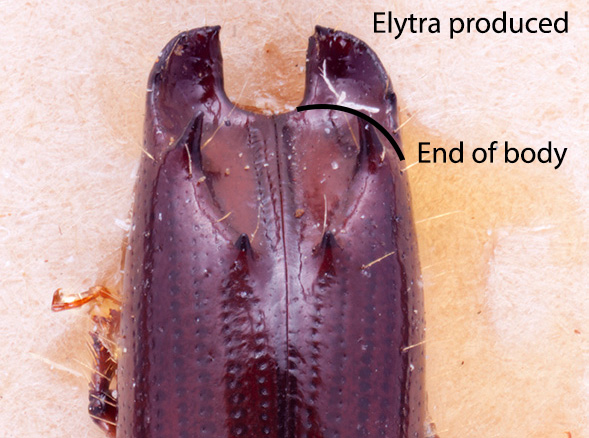 per gallery. The species is strongly attracted to ethanol (e.g. Markalas and Kalapanida 1997Markalas and Kalapanida 1997:
per gallery. The species is strongly attracted to ethanol (e.g. Markalas and Kalapanida 1997Markalas and Kalapanida 1997:
Markalas S, Kalapanida M. 1997. Flight pattern of some Scolytidae attracted to flight barrier traps baited with ethanol in oak forest in Greece. Anzeiger fuuml;r Schauml;dlingskunde, Pflanzenschutz, Umweltschutz 70: 55-67. https://doi.org/10.1007/BF01996922, Saruhan and Akyol 2012Saruhan and Akyol 2012:
Saruhan H, Akyol I. 2012. Monitoring population density and fluctuations of Anisandrus dispar and Xyleborinus saxesenii (Coleoptera: Scolytinae, Curculionidae) in hazelnut orchards. African Journal of Biotechnology 11: 4202-4207. http://dx.doi.org/10.5897/AJB11.4185). It is a pest of hazelnut in the Mediterranean area (Saruhan and Akyol 2012Saruhan and Akyol 2012:
Saruhan H, Akyol I. 2012. Monitoring population density and fluctuations of Anisandrus dispar and Xyleborinus saxesenii (Coleoptera: Scolytinae, Curculionidae) in hazelnut orchards. African Journal of Biotechnology 11: 4202-4207. http://dx.doi.org/10.5897/AJB11.4185), and of stressed trees in fruit orchards and forest plantations. Damage to timber is also caused by the galleries and associated staining of the wood (Chararas 1962Chararas 1962:
Chararas C. 1962. Eacute;tude biologique des scolytides des conifegrave;res. Encyclopeacute;die Entomologique, Ser A, 38. Lechevalier, Paris viii + 556 pp.).
DNA data
Sequences available for COI and CAD.
COI: HM064112; MN620028; MN620030; MN620031; MN620032; MN620033; MN620034; OP617762; OP617789
CAD: HM064290; MN620293; MN620296; MN620298; MN620299; MN620300; OP607191; OP607219


